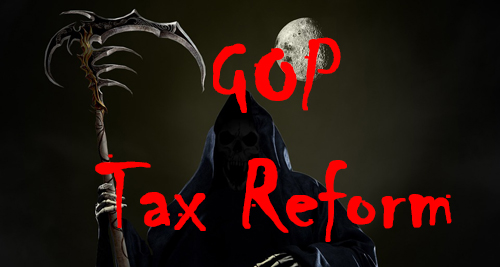The House passed the Tax Bill of Doom today with no Democratic votes, and now it’s up to the Senate. A former senior aide to George W. Bush puts its chance of passing in the Senate at 70 percent. Fortunately there are significant differences between the House and Senate bills that might make those odds worse. But maybe not worse enough.
This is an unpopular bill. The Senate bill kills the individual mandate to buy health insurance; without that, Obamacare is dead. It also has an immediate $25 billion cut from Medicare. The House bill eliminates deductions for medical expenses in 2018. This would be a disaster for most older people and all people with medical issues. The wealthy, of course, make out like bandits.
The Republicans’ theory about their tax-cut bill goes like this. We absolutely have to pass it, or else our base will be disgusted and our donors will abandon us. The substance doesn’t matter — we’ll get it past complex Senate rules, and even if some provisions look troubling, after it passes we can have a triumphal Rose Garden ceremony and proclaim we’ve delivered prosperity for all. In coming months and years, people won’t remember the details, as long as we keep saying “We cut taxes” over and over again.
That theory is going to be put to the test, and I’m pretty sure it’s going to be proven wrong. That’s because this bill won’t just fail to deliver on its promise of riches trickling down to everyone; it’s actually going to be a disaster for millions of Americans. And there’s not going to be any doubt about who inflicted it on them.
To start, the tax cuts will not increase growth and, given their fiscal effects, would likely have a significant and increasingly negative impact. The nonpartisan Tax Policy Center’s latest report estimated that, over 10 years, the average increase in our growth rate would be roughly zero, counting the crowding out of private investment by increasing deficits but not counting other adverse effects of worsening our fiscal outlook. The Penn Wharton Budget Model, using the same approach, estimates virtually no increase in long-term growth. Goldman Sachs projects an increase of 0.1 percent to 0.2 percent in the first couple of years and an average increase over 10 years of just 0.05 percent per year, not counting any of the adverse fiscal effects. …
…Adding $1.5 trillion or more to the federal debt would make an already bad situation worse. A useful measure of our fiscal position is the ratio of publicly held government debt to economic output or gross domestic product, called the debt/GDP ratio. In 2000, the debt/GDP ratio was 32 percent. The ratio is now 77 percent. Looking forward, the CBO projects the debt/GDP ratio to be 91 percent in 2027 and 150 percent in 2047. After $1.5 trillion of deficit-funded tax cuts, those future ratios have been estimated to increase to roughly 97 percent in 2027 and 160 percent in 2047. These estimates likely substantially understate the worsening of our fiscal trajectory. That’s because they do not account for the increasingly adverse effect on growth of the difficult-to-quantify effects of fiscal deterioration.
So why are the Republicans determined to pass this disaster?
In a candid moment last week, Rep. Chris Collins conveyed out loud what many members have been thinking for months.“My donors are basically saying, ‘Get it done or don’t ever call me again,'” the New York Republican told The Hill.

